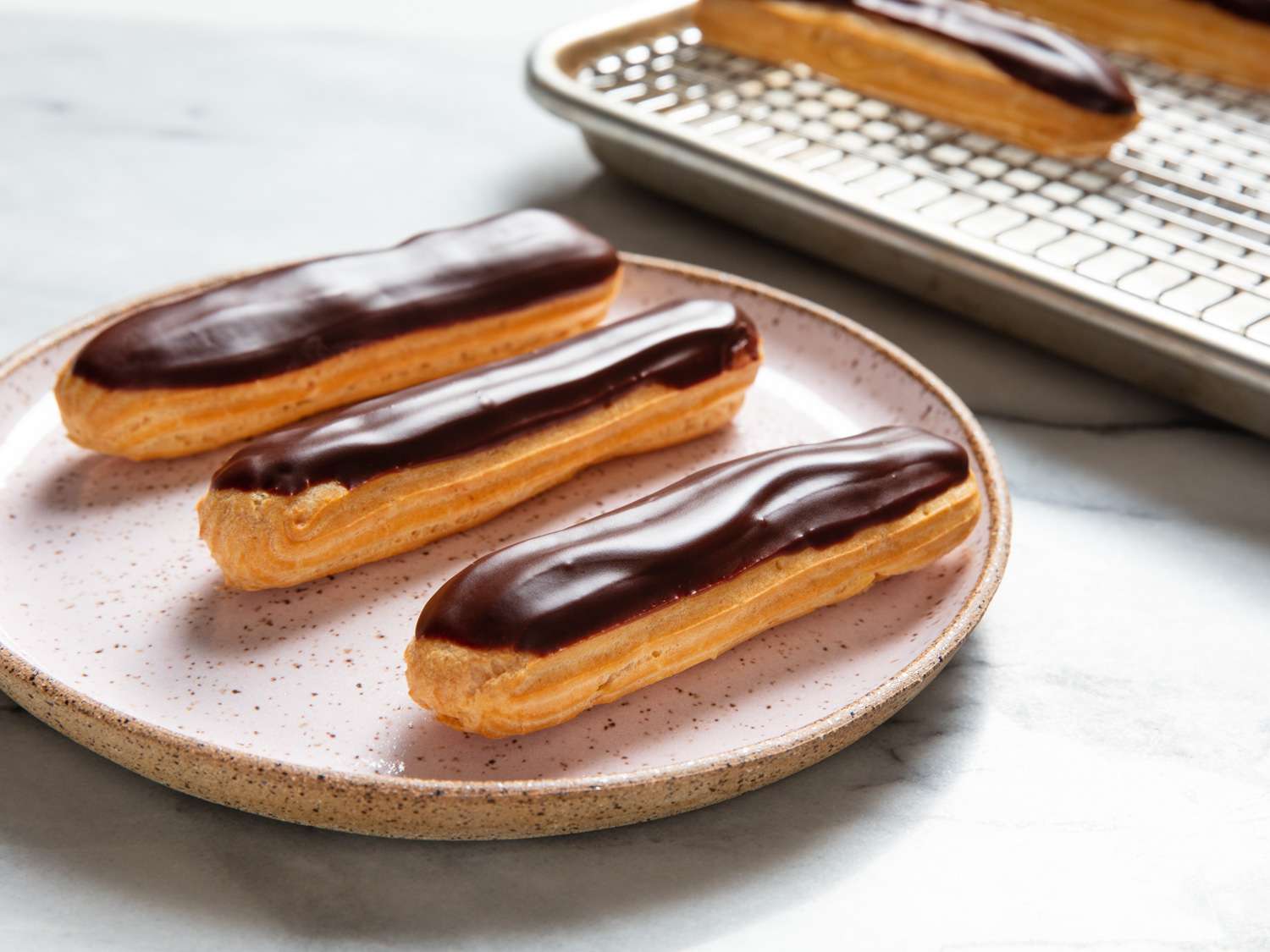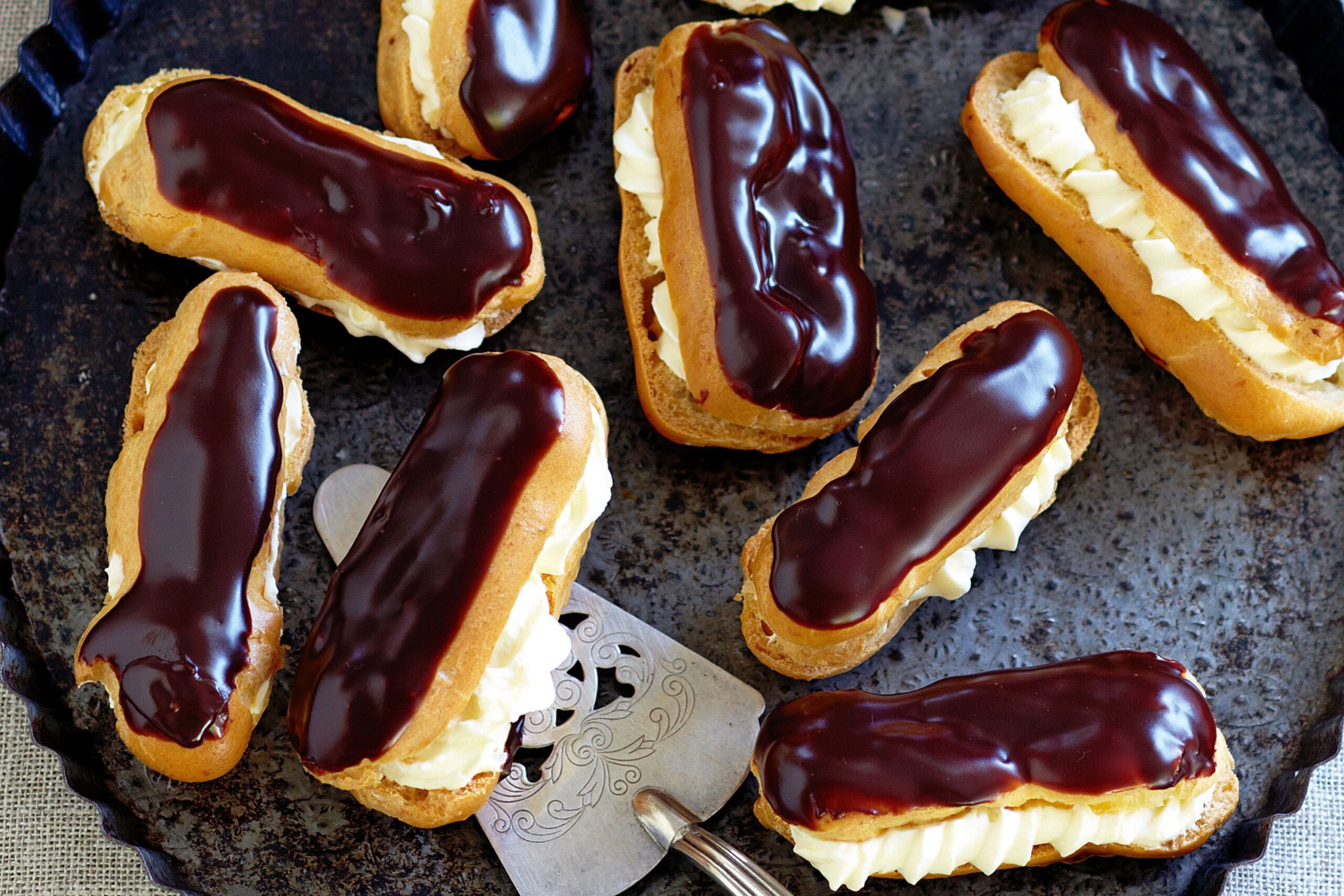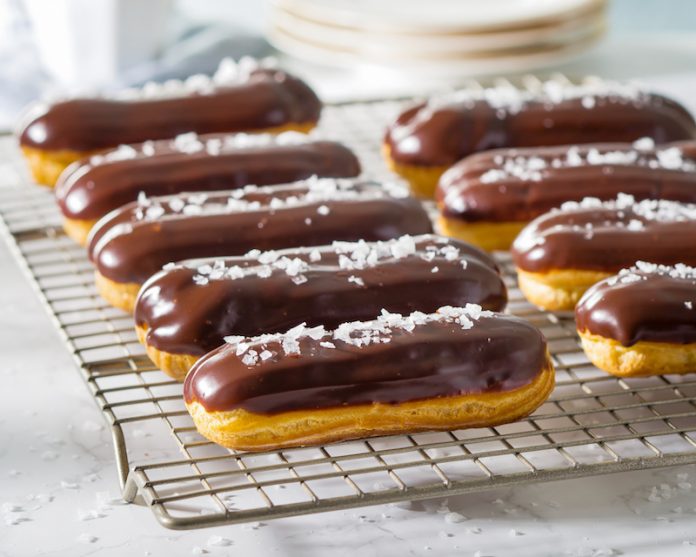List Of Contents
The éclair, a delicate and elegant French pastry, is a culinary masterpiece that has delighted dessert lovers for centuries. Known for its elongated shape, crisp choux pastry shell, creamy filling, and glossy glaze, the éclair is a staple in patisseries around the world. This article explores the history, preparation, variations, and cultural significance of éclairs, highlighting why this timeless pastry remains a beloved indulgence.
Historical Origins Éclairs

The éclair’s history is deeply rooted in French pastry tradition. The word “éclair” means “flash of lightning” in French, which is believed to refer to the pastry’s shiny glaze that resembles a flash or the speed at which it is typically eaten, implying its irresistible nature.
Éclairs are thought to have been created in the early 19th century by Marie-Antoine Carême, a renowned French chef and pastry artist known for his elaborate and inventive culinary creations. Carême is often credited with perfecting the choux pastry, or pâte à choux, which is the foundation of many classic French pastries, including the éclair.
The Art of Making Éclairs
Creating the perfect éclair requires precision, skill, and an understanding of the delicate balance between the pastry, filling, and glaze. The process involves several key steps, each contributing to the éclair’s distinctive texture and flavor.
Choux Pastry (Pâte à Choux)
The base of an éclair is choux pastry, a light and airy dough made from butter, water, flour, and eggs. The dough is cooked twice: first on the stovetop and then in the oven. Here is the process:
- Cooking the Dough: The dough starts by boiling water and butter together, then adding flour and stirring vigorously until a smooth, cohesive dough forms. This mixture is then cooked briefly on the stovetop to remove excess moisture and ensure the dough is properly gelatinized.
- Incorporating Eggs: After the dough has cooled slightly, eggs are gradually added, creating a smooth, glossy batter. The eggs provide the structure and leavening needed for the pastry to puff up and form a hollow center during baking.
- Piping and Baking: The dough is transferred to a piping bag fitted with a large round or star tip and piped into long, finger-like shapes onto a baking sheet. The éclairs are then baked at a high temperature to create steam, which puffs up the pastry, forming the characteristic hollow interior. The temperature is then reduced to ensure the éclairs bake through and develop a crisp exterior.
Filling
The traditional filling for éclairs is pastry cream (crème pâtissière), a rich and creamy custard made from milk, eggs, sugar, and cornstarch or flour. The pastry cream is often flavored with vanilla, but variations include chocolate, coffee, or fruit flavors.
- Making the Pastry Cream: The milk is heated with a portion of the sugar until it reaches a simmer. Meanwhile, the remaining sugar is whisked with egg yolks and cornstarch to create a smooth mixture. The hot milk is then gradually added to the egg mixture, tempering the eggs, before the entire mixture is returned to the stovetop and cooked until thickened. The pastry cream is then cooled and often mixed with butter to achieve a silky texture.
- Filling the Éclairs: Once the éclairs are baked and cooled, small holes are made in the ends or bottom of each éclair, and the pastry cream is piped inside using a piping bag fitted with a small tip. The goal is to fill the éclair evenly without overfilling, which could cause the pastry to burst.

Glazing
The final step in creating éclairs is the glaze. The traditional glaze is chocolate, made from melted chocolate and sometimes butter or cream for added shine and smoothness. Other popular glazes include caramel, coffee, or fruit-flavored glazes.
- Preparing the Glaze: For a chocolate glaze, chocolate is melted gently and combined with butter or cream. The glaze should be smooth and glossy, with a consistency that allows it to coat the éclairs evenly without dripping excessively.
- Applying the Glaze: The filled éclairs are dipped into the glaze, or the glaze is poured over the top using a spoon or piping bag. The goal is to achieve a smooth, even coating that enhances the éclairs’ appearance and adds a contrasting texture to the crisp pastry and creamy filling.
Variations and Innovations
While the classic éclair is filled with vanilla pastry cream and topped with chocolate glaze, modern pâtissiers have introduced a wide range of innovative flavors and presentations, transforming the éclair into a versatile and creative dessert.
- Flavor Variations: Éclairs can be filled with various flavored creams, such as pistachio, hazelnut, lemon, raspberry, and more. Savory versions, filled with ingredients like cheese, smoked salmon, or foie gras, have also gained popularity.
- Glaze and Topping Innovations: Beyond the traditional chocolate glaze, éclairs can be topped with colorful glazes and decorative elements. For example, fruit glazes made from puréed berries or citrus add vibrant colors and fresh flavors. Toppings like nuts, edible flowers, and gold leaf can elevate the éclairs’ visual appeal.
- Mini Éclairs and Éclair Towers: For special occasions, mini éclairs and towering éclair displays have become trendy. Mini éclairs offer a bite-sized version of the classic, perfect for dessert tables or as part of a dessert assortment. Éclair towers, similar to croquembouche, create a stunning centerpiece for events and celebrations.
Cultural Significance
Éclairs hold a special place in French culture and patisserie. In France, éclairs are a common sight in bakeries and patisseries, where they are often enjoyed as an afternoon treat or a special latoto dessert. The artistry involved in creating éclairs is a testament to the skill and dedication of French pastry chefs, who strive to perfect the delicate balance of texture and flavor.
Beyond France, éclairs have become a popular dessert worldwide, with each country adding its unique twist. In Japan, for example, matcha-flavored éclairs are a favorite, while in the United States, éclairs are often featured in gourmet bakeries and high-end dessert menus.
The Science Behind Éclairs
 Food
Food
Understanding the science behind éclair making can enhance the baking process and the final product. The key to a perfect éclair lies in the interaction of ingredients and the precise execution of techniques.
Steam and Puff
The puffing of choux pastry is driven by steam. When the dough is baked at a high temperature, the water in the dough turns to steam, causing the pastry to rise and create a hollow center. The structure of the dough, strengthened by the gelatinization of starch and the coagulation of proteins, allows the pastry to hold its shape while expanding.
Creamy Filling
Pastry cream relies on the thickening properties of eggs and starch. As the mixture is heated, the starch granules absorb liquid and swell, while the proteins in the eggs coagulate, creating a thick and stable custard. The balance of these ingredients ensures a smooth and creamy texture that can be piped easily into the éclairs.
Glazing Technique
The glaze not only adds flavor but also enhances the éclairs’ visual appeal. The smoothness and shine of the glaze are achieved by controlling the temperature and consistency of the chocolate or other glazing ingredients. Properly tempered chocolate will set with a glossy finish and a pleasant snap, adding to the éclairs’ overall texture.
Conclusion: A Timeless Delight
Éclairs, with their delicate choux pastry, luscious filling, and elegant glaze, continue to captivate dessert lovers around the world. From their origins in 19th-century France to their modern-day adaptations, éclairs have maintained their status as a symbol of culinary excellence and creativity.
The artistry and precision required to make éclairs reflect the dedication of pastry chefs to their craft, while the endless possibilities for flavors and presentations ensure that this classic pastry remains relevant and exciting. Whether enjoyed in a traditional patisserie or as part of a contemporary dessert menu, éclairs offer a delightful and indulgent experience that transcends time and borders.
As the world of pastry continues to evolve, the éclair’s legacy as a timeless delight endures, promising to enchant new generations of pastry enthusiasts and food lovers alike.
Read More Article About “Kenikmatan Salad Thailand: Rasa, Sejarah, dan Manfaat Kesehatan“


